Hozoin-ryu: Thrust like a spear, sweep like a naginata, reap like a sickle
Text and Photos by Grigoris Miliaresis

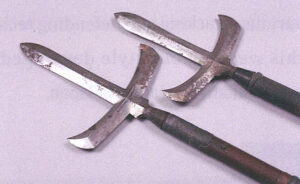
The cross-shaped kamayari
It started with a book; in the pre-Internet 1990s most things started with a book or TV, and in this case it was Dave Lowry’s “Autumn Lightning: The Education of an American Samurai”. In it and in alternating chapters, Lowry tells his story of discovering Yagyu Shinkage-ryu through a Japanese expat who lived in his area and the story of the school itself and on chapter 6, “The Swordsmen in the Shadows” he recounts the first meeting between Kamiizumi Nobutsuna, founder of Shinkage-ryu and Yagyu Munetoshi, his most famous student and founder of the Yagyu fraction of the school. And since the place of the meeting was Hozoin temple in Nara (a sub-temple of the famous Kofukuji temple) and the middleman for the meeting its abbot, Kakuzenbo In’ei, Lowry spends a few pages describing the Hozoin monks and their specialty, spear-fighting –including the story about how In’ei, inspired by the reflection of the crescent moon on Kofukuji’s Sarusawa pond crossing his spear, attached a short blade perpendicular to it creating the 8-sided blade, cross-shaped kamayari that became the trademark of the Hozoin-ryu of spear-fighting.
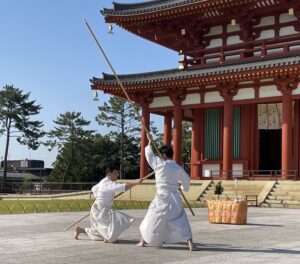
Hozoin-ryu demonstration at Kofukuji temple

Spear with a brass mid-joint
My personal interest in long weapons led me to Tenshin Buko-ryu, a school whose studies include a kagitsuki naginata i.e. one with a crosspiece attached to the base of its blade –the moment I saw it, Hozoin-ryu’s kamayari came to mind and in the available videos (and later, when I came to Japan, live demonstrations), I noticed that the way the two weapons were used were very similar. Especially when Buko-ryu puts the kagitsuki naginata against a straight (or “su”) yari, like the Hozoin-ryu does, the way the naginata fighter uses the crosspiece of his weapon to manipulate the opponent’s in circular motions and through the use of leverage and adjustments of distancing could have been taken out of Hozoin-ryu’s playbook. And considering how well-spread Hozoin-ryu was during the Edo Period all over Honshu (including Kanto, Buko-ryu’s birthplace), it might very well have been. One major difference? Size! Hozoin-ryu’s kamayari is 2.7m (9 shaku/feet) and the su yiari it’s pitted against is a whopping 3.6m (12 shaku/feet or 2 ken). And if you are wondering how Hozoin-ryu practitioners fit them in Tokyo’s public transportation, the answer is they use spears with brass mid-joints which, as I would find out later were extremely sturdy!
From Nara to Tokyo
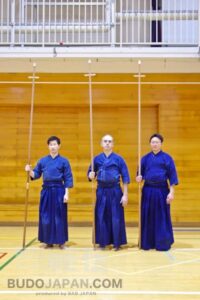
(L-R) Nishimoto Yoshihisa, Grigoris Miliaresis, Komakita Manabu Shigeyoshi
How did I find out? By visiting their Tokyo dojo, of course! Which, as chance would have it and as if to make things easier is headed by one of my Ono-ha Itto-ryu seniors, Nishimoto Yoshihisa. Intense and meticulous but always kind and always with a deadpan expression, Nishimoto-sensei has been extremely helpful with Itto-ryu and he was too in arranging this visit, which coincided with the school’s 22nd and current head, Komakita Manabu being in town for the annual Nihon Kobudo Kyokai demonstration at the Nippon Budokan.
Back in my Dave Lowry-reading days, this article would have to be twice as long to include a history of Hozoin-ryu from the time of Kakuzenbo Inei, back in the mid-16th century, through several generations of Hozoin priests and simultaneously through secular students including Nakamura Naomasa (founder of the Nakamura-ha line of the school) and Takada Matabei Yoshitsugu (founder of the Takada-ha line which is Komakita-sensei’s), its move to Edo, its ups and downs with the ebb and flow of history and then its rebirth and return to Nara in the 1970s through the efforts of its’ 18th head Kazuto Ishida, 5th Chief Justice of Japan, 2nd president of the All-Japan Kendo Federation and 5th head of Yamaoka Tesshu’s Itto Shoden Muto-ryu. Thankfully, nowadays Hozoin-ryu has its own website so you can learn its history directly from it –and I can go directly to practice!
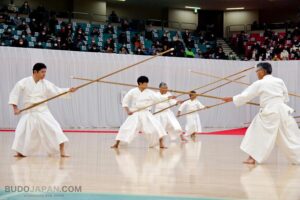
Hozoin-ryu Takada-ha Sojutsu demonstration at the 46th Nihon Kobudo Taikai in the Nippon Budokan
A long spear –and how to handle it

Left, kamayari (~2.7 m), right: suyari (~3.6m)
Spears are long weapons and Hozoin-ryu’s are extra long; in Buko-ryu we use a 9 shaku spear which is as long as Hozoin-ryu’s cross-shaped kamayari but thicker i.e. less prone to oscillation i.e. easier in some respects. The real difference is in use though: since Buko-ryu is a naginata school, the spear technique is very basic and only consists of thrusts with the naginata (which is 7 shaku/2.1m/7 feet) doing the more sophisticated movements. Hozoin-ryu works pretty much the same way, but the simple weapon is 12 shaku and the more elaborate, 9 which means that in transferring my experience from the one school to the other, I had to add another 2 shaku (60 cm/2 feet) to the distance I am used to –for weapons where 1 cm/0.4” is the line between life and death, 2 shaku is an incredibly large margin.
To give such a long weapon a steady base, you need a deep stance and Hozoin-ryu’s is one of the lowest I have seen with the toes pointing outwards, the knees bent, the hips low and the back straight, the spear at a horizontal position at about waist level, and the two hands held about one meter (3’2”) apart; if nothing else, this is a practice that builds amazing quadriceps! The weapon is held with the left hand forward and the back hand almost at the butt (ishizuki); the front hand has the standard “tennis racket” grip (aka “tiger’s mouth”) and must be relaxed because to achieve the optimum use of leverage (and therefore have the most effective use of the weapon with the least effort) the front hand is mostly the fulcrum with the back hand doing the bulk of the work in thrusting, pulling, rotating or slamming down the opponent’s spear.
Building technique
Hozoin-ryu’s current curriculum consists of two sets of 14 kata (Omote and Ura) and one set of 7 kata (Shinshikake) respectively attributed to Kakuzenbo In’ei and Takada Matabei Yoshitsugu. Omote and Ura have the same names because they are variations of each other while Shinshikake are more fanciful and involve more unusual techniques like one-handed thrusts or ishizuki strikes. For our lesson, Komakita-sensei started with the six essential building blocks of the Hozoin-ryu kamayari technique: the tsuki (thrust), the kanmuri (high block), the kakoi (low block), the makiotoshi (rotating take-down using the crosspiece), the hikiotoshi (pulling take-down, again using the crosspiece) and surikomi (entering and using the horizontal blade to cut the opponent’s hand).

Hikiotoshi 1 (Pulling back the right hand; the opponent’s spear is not dropped using the left hand.)
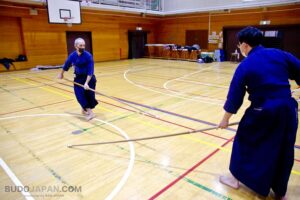
Hikiotoshi 2 (Letting the opponent’s force flow past.)
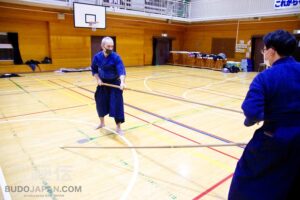
Hikiotoshi 3 (Thrusting the opponent if they don’t pull back their spear.)
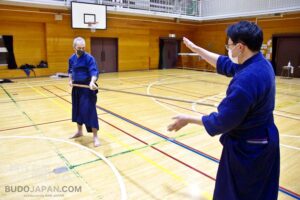
Explaining the concept of uroko (ensui)
If this six are the blocks, the cement binding them together is the concept of “uroko” (fish-scale); exotic as it might seem, this refers to a triangular shape with a curved base although a better way to understand it would be as a cone (ensui) which Komakita-sensei used throughout his teaching. The Hozoin-ryu spear fighter thinks of himself as being on the diameter of this cone’s round base and the cone extends in front of him and narrows to the center line of his opponent. As he moves he tries to keep the opponent’s spear at an angle so it will always be to the sides of the cone, allowing him to always be out of harm’s way but only barely so. If this sounds like a scary place to be, it actually isn’t and this is something that I can testify from my experience in Buko-ryu where we are using the same principle but without the uroko/ensui terminology.
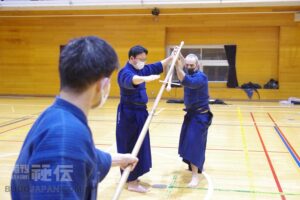
Kanmuri 1 (Entering the cone.)
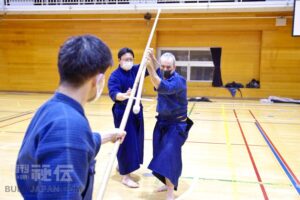
Kanmuri 2 (Keep pressuring using the spear’s tip.)
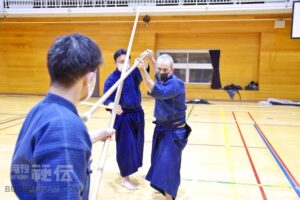
Kanmuri 3 (Kanmuri-tsuki: Going straight in and thrusting.)

Makiotoshi 1

Makiotoshi 2 (Rotating take-down using the spear’s crosspiece.)
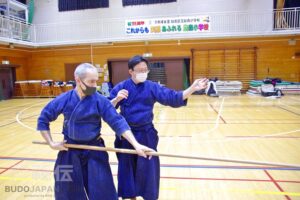
Makiotoshi 3 (Rotating the spear using a bigger rotation of the right hand and a smaller rotation of the left hand.)
And it makes perfect sense: the safest place to be against a longer weapon (and deceptively fast weapon) that can be as deadly thrusting front as it is cutting when drawn back, is past its blade and closer to the opponent, like when using a kodachi against a long sword. Pushing away the longer weapon it will naturally circle back to you but sliding past its tip, you are inside the opponent’s space and their weapon isn’t actually dangerous unless they drastically change their distancing to their advantage. Hence, irimi i.e. “entering” is one Hozoin-ryu’s three pillars (the other two are ensui and kama, the crosspiece blade of the weapon).
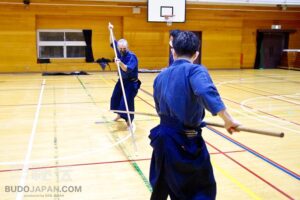
Kakoi 1 (Entering the cone.)

Kakoi 2 (Kakoi-tsuki: Pushing in with the spear tip in place and thrusting the opponent.)

Kakoi 3 (The back hand can be lowered to the waist while attacking the center and the spear can be pulled back and held there.)
Square one: Toyo
Putting all the above together, we moved to the first kata, Toyo, which in Omote utilizes tsuki, kanmuri, kakoi, makiotoshi and hikiotoshi and in Ura changes the final hikiotoshi to surikomi. Hozoin-ryu thinks of Toyo as “the most basic among basics” and one can easily see why: mastering it from both sides, you can unlock the school’s whole curriculum. The kata’s structure is as follows: as the two opponents approach, the su yari attempts a high thrust at the kamayari to which the latter responds with a kanmuri high block i.e. raising both hands, bringing the weapon in a downward direction and stopping the incoming thrust near the crosspiece.
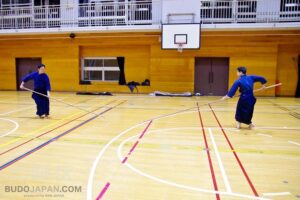
Toyo 1 (The two opponents approach.)
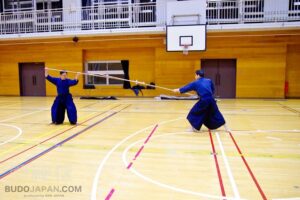
Toyo 2 (Kanmuri: the suyari attempts a high thrust at the kamayari to which the latter responds with a kanmuri high block.)
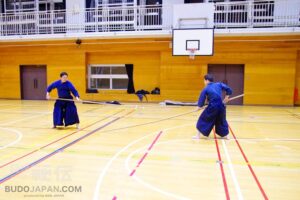
Toyo 3 (Makiotoshi: bringing the weapon in a downward direction and stopping the incoming thrust near the crosspiece.)
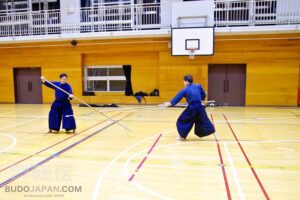
Toyo 4 (Kakoi: the suyari attempts a low thrust which the kamayari stops with a kakoi low block.)
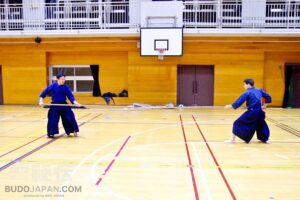
Toyo 5 (The two opponents bring their weapons to a balanced middle-level position.)
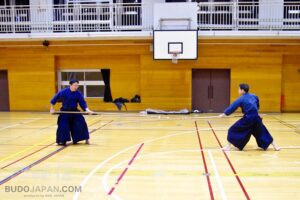
Toyo 6 (The suyari disengages.)

Toyo 7 (Hikiotoshi: the suyari then attempts another high thrust to which the kamayari responds by pulling back so the crosspiece catches the suyari near its tip and slams it down.)
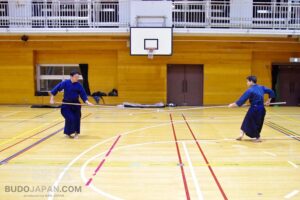
Toyo 8 (As the suyari retreats, the kamayari also closes the distance and confirming its win and both sides restore their weapons to their original positions.)
Here, using the cone principle, the kamayari fighter could step right in and finish the opponent but instead takes his weapon down with a makiotoshi where the crosspiece catches the long spear as the back hand goes down to the waist. Immediately then, the su yari attempts a low thrust which the kamayari stops with a kakoi low block, this time raising only the back hand. The two opponents bring their weapons in a balanced middle-level position with the kamayari side advancing and the su yari retreating and from there, the su yari attempts another high thrust to which the kamayari responds by pulling back so the crosspiece catches the long spear near its tip and slams it down –this part is the hikiotoshi. In the Ura version of the Toyo, the kamayari would step in (irimi) and would cut the opponent’s hand using the kama as a blade.
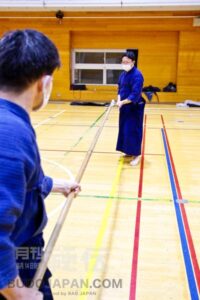
Surikomi 1
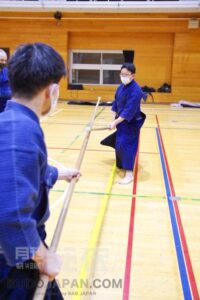
Surikomi 2 (Irimi: the kamayari could step in.)

Surikomi 3 (The kama yari could cut the left thumb using the kama as a blade.)
Complicated as it might sound, this is a very basic exchange; for someone who has already done the kanmuri, kakoi, makiotoshi and hikiotoshi techniques (in Buko-ryu the first two are “kasumiuke” and “irimi” and the other two are also “makiotoshi” and “hikiotoshi”) they are almost instinctive. But “basic” doesn’t mean “easy” and as I mentioned before, the different lengths and thicknesses of the weapons and the very low stance that Hozoin-ryu utilizes, made doing even this most elementary kata, quite challenging. And of course getting the moves right is just the first step: doing everything with a constant feeling of seme (pressure) towards the opponent, always adjusting the distance and staying relaxed so you can be fast and not create tells that will allow the opponent to anticipate your moves are added levels of complexity that make things even more difficult. Which is the flip-side of “interesting”.
Back to Nara –and the world
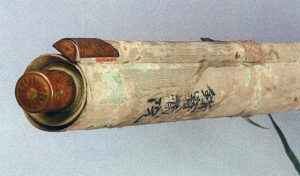
Hozoin-ryu’s densho
My introduction to Hozoin-ryu was as exciting as I expected it to be and I would certainly recommend it to anyone interested in long weapons; if they wanted to focus on the spear, it would be practically an one-way street since very few the schools specialize in it. Which brings me to one of the most interesting aspects of Hozoin-ryu: its work to disseminate the art as much as possible. With dojo in Nara, Tokyo and Nagoya as well as abroad (Germany and Canada), the school has already a good base but even more than that, the last three headmasters (Kagita Chubei, who was also a mayor of Nara, Ichiya Junzo and Komakita Manabu) have gone into great lengths to promote it as an essential part of Nara’s culture. Participating in numerous demonstrations, holding special classes for children with special publications targeting them, staging events and even planting their own trees so future practitioners will have the material needed for their weapons (timber for long weapons has being an issue in Japan lately), Hozoin-ryu does its best to make sure that it will not only survive in the future but it will also thrive and if it is led by people like Komakita Manabu and Yoshihisa Nishimoto, I have no doubt it will!
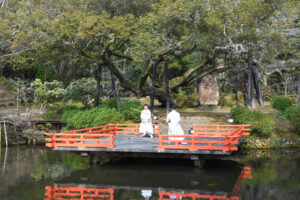
Hozoin-ryu demonstration in Nara’s Kasuga-Taisha.
PS
As is in all “experience” articles, there are not enough words to thank Komakita Manabu and Yoshihisa Nishimoto for their instruction and the members of the Tokyo Dojo of Hozoin-ryu for allowing us to disturb their practice and to monopolize the attention of their teachers. I hope this article will draw enough attention to Hozoin-ryu to compensate for their loss.
PPS
The title is a phrase from a poem by an early Hozoin cleric/spearman, Incho, that has become the slogan of Hozoin-ryu.
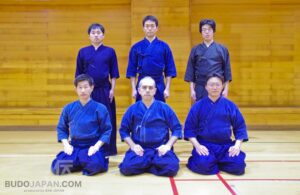
Hozoin-ryu’s Tokyo dojo.

Grigoris Miliaresis
About the writer
Grigoris Miliaresis has been practicing Japanese martial arts since 1986. He has dan grades in judo, aikido and iaido and has translated in Greek over 30 martial arts’ books including Jigoro Kano’s “Kodokan Judo”, Yagyu Munenori’s “The Life-Giving Sword”, Miyamoto Musashi’s “Book of Five Rings”, Takuan Shoho’s “The Unfettered Mind” and Donn Draeger’s “Martial Arts and Ways of Japan” trilogy. Since 2007 his practice has been exclusively in classic schools: Tenshin Buko-ryu Heiho under Ellis Amdur in Greece and Kent Sorensen in Japan and, since 2016, Ono-ha Itto-ryu under 17th headmaster Sasamori Takemi and 18th headmaster Yabuki Yuji.














